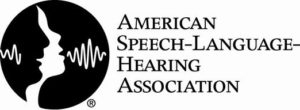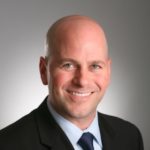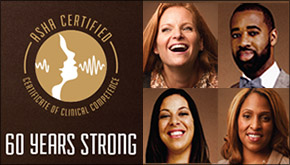Hear That Sound? It’s the American Speech-Language-Hearing Association Engaging Members from Day One
 Since becoming Director, Membership for the American Speech-Language-Hearing Association (ASHA) in 2013, Mike Skiados, CAE has enjoyed a 98 percent member retention rate. ASHA is the national professional, scientific and credentialing association for more than 198,000 audiologists, speech-language pathologists, and speech, language and hearing scientists. ASHA certifies these professionals to work across the country and sets standards for advancing science and excellence in professional practice.
Since becoming Director, Membership for the American Speech-Language-Hearing Association (ASHA) in 2013, Mike Skiados, CAE has enjoyed a 98 percent member retention rate. ASHA is the national professional, scientific and credentialing association for more than 198,000 audiologists, speech-language pathologists, and speech, language and hearing scientists. ASHA certifies these professionals to work across the country and sets standards for advancing science and excellence in professional practice.
Skiados credits ASHA’s successful member engagement and retention levels with a focused strategy of engaging members from day one of their membership. He advocates voraciously listening to what individual members want from their membership – fitting for an association of audiologists and speech pathologists.
We talked about the kind of association experience ASHA strives to provide its members, why segmenting individuals along age-based criteria isn’t a good idea, and how ASHA is learning to counter “fake news” while reinforcing trust in association-sourced knowledge.
Association Adviser: Tell us how you got into working for associations.

Mike Skiados: My father, Don Skiados, was an association executive with the Air Line Pilots Association for 40 years. He worked his way up to being their executive director. So I knew about the possibility of working with associations growing up. When I graduated college I worked in hospitality sales for a number of years before getting the opportunity, through the Greater Washington Society of Association Executives, to move to association side. I worked with Lori Derkay, CAE, on operations. Then GWSAE merged with ASAE, and I moved into a role working with the Greater Washington community – the “GW Network” – of ASAE. That was my introduction to the leadership side of associations. I loved it and have been there ever since.
AA: You’ve worked at the C-Level in associations before. What motivated you to take a position at the director level?
MS: I like to keep learning. I took a role as COO to get a better understanding of corporate finance and a full look at how to understand an organization’s financial health. I received a great background and holistic view of corporate finance. But then I had an opportunity to move over to ASHA and work with Arlene Pietranton, PhD, CAE, ASHA’s CEO. She had some interesting, brilliant initiatives going on to expand ASHA’s outreach. The scope of the position was larger: I moved from managing a $1.5 million budget to generating $40 million in revenue as well as managing project teams of more than 50 people. So the title may not translate into higher level of responsibility but the work does.
AA: What is your ultimate career goal?
MS: Working with association volunteers to figure out the strategic direction for an organization. I’ve been able to help volunteers channel ideas and put together strategic plans for achieving their goals. I want to keep doing that in the future. Further down, I definitely see myself in an executive director role for a strategic association.
AA: In your experiences as a membership director, what do members expect from an association membership?
MS: I think members expect the association to understand who they are, and be able to provide relevant resources to help them become better at their jobs. The big piece is this: Membership directors must listen to their membership to understand what benefits they’re looking for so they can work on providing them and communicating that member value proposition. Often, you run into a member who says, “I really wish you provided this to members.” And the association does have that benefit or service; the member just hasn’t found it yet!
To attract and keep members, I think a director of membership needs to be able to communicate to each individual in a relevant way about the benefits they’re going to receive. Whether those benefits are knowledge-based or evidence-based tools, continuing education opportunities, an advocacy program that will help them find an easier path to work, a community that helps people connect with experts who help them grow, or certification that’s going to help them stand out among their professional peers, a director of membership needs to understand what benefits individual members want and know how to provide them.
AA: You’ve served with the ASAE Young Professionals Committee. How did that experience shape your views on association membership, and what it should look like?
MS: That experience made me to feel like I was giving something back or passing it forward like those association executives before me did. I also don’t want anyone that reads this to think I am old, but I have served in a lot of different liaison roles, a lot of different committee positions, a lot of different organizations, and I do think I have a lot to offer, but every time I worked with this group I learned something too.
One of the things I think people who are established in associations and responsible for creating membership growth invest heavily in are ways to group people to know how to better communicate with them. While I think there’s a lot of value in segmentation and being able to understand what a certain membership group may be able to do or be more likely to do, I don’t think there’s a whole lot of utility to basing any kind of communication on age-based segmentations. I think individual are individuals. What I learned from working with the ASAE Young Professionals group was that they fit into a lot of demographics based on professional interests, background, association size, and other things along those lines. You couldn’t identify them based on age.
There’s an effort to say, “Well, Millennials want to be involved in this type of program,” but there’s no real data behind Millennial preferences in associations that differs from other age segments. They want to see value. They’re looking for ROI just like other members. That’s not just a Millennial thing; that’s a societal thing. People overall are looking for concrete reasons to join an association and what they’ll get out of it.
I’d rather segment members based on what programs they’ve attended or what special interest group they’ve been involved with, or what articles they’ve read. We have a lot of data on individual members, and we can use segmentation and propensity modeling to understand what a group of people may be interested in engaging with or buying in the future, but we shouldn’t use personal demographics to make those decisions. You wouldn’t base membership activity on other demographic factors like race. A member is an individual. Get to know them as an individual.
AA: What kind of membership experience are you striving to provide for ASHA members?

MS: The goal is for members to truly value ASHA. To accomplish that, we’re trying to create an informed, engaged membership. One thing we’ve created recently to help us get there is a new members welcome campaign. When a new member joins ASHA, and they receive their certification [ASHA administers the Certificate of Clinical Competence (CCC), a nationally recognized professional credential that represents a level of excellence in the field of Audiology (CCC-A) or Speech-Language Pathology (CCC-SLP)], they move into a series of welcome emails. We block all other communication for the first eight weeks of membership and focus on educating them about what ASHA can provide for them. Our members often call to ask for something we already provide. So we aim to educate members about being an ASHA member. The first email leads them to places on our website that tell them how to craft their personal membership experience. The next piece talks about benefits of certification, then knowledge resources, advocacy, partner associations, money-saving benefits, and so on.
These messages are designed to educate each member about ASHA’s resources for them and give them custom, personal membership experiences that will hopefully make them into an engaged, satisfied member for years to come.
AA: Where do you and your team look for input on the strategic direction of ASHA’s membership programming and marketing?
MS: Everywhere! We are always looking to improve by listening to members. We have a number of member satisfaction surveys that go out during the year.
Additionally, we are out educating ourselves with resources from ASAE and other organizations as we try to better understand association management principles. We attend leadership and technology conferences, and we have a lot of people from our team engaging with ASAE. Recently, a team member took a class on contracts and how to get the best deals with affinity partners. Taking that class outside of the association world has really helped us expand affinity benefits.
Every resource is a good resource. We look at what other associations of like size are doing. Sometime we’re the lead and sometimes we’re looking at other associations to see how their activity could inform what we do, but we’re always scanning.
AA: What major trends or factors do you think will affect association membership levels/activity in the next five to 10 years?
MS: I think there are two big related trends: the mobile movement and where members are access information. Everyone always has their mobile device in their hand and information at the tip of their fingers. With the mobile piece, at minimum we need to make sure we have a responsive design to our websites and resources, which ASHA does. We need to understand that members are looking at their devices more often than not when connecting with us through our website, our emails and our social media. Messages must be quick and concise with links to further information if they want to learn more. We need to know what actual content they’re looking for and make it very easily accessible.
The second trend is being aware of how easily members can find answers to their questions outside of the association and reminding them that association media can be trusted. Associations should communicate to members that they are the source for vetted information about whatever professional subject they’re looking for. Members should say, “I know I can ask Google a question, but can I trust it as much as I can trust the info coming from my organization?” The level of content coming from the association, whether written by members or by staff, should be held at a higher level and be more trusted level than something people can find through a regular search engine.
AA: Has recent climate of fake news affected ASHA?
MS: Demeaning the news media isn’t good for ASHA or any association or our country. We must have an open and free press. At ASHA we do our best to provide the media with our research and our governing body positions on issues affecting speech and hearing. Sometimes we are ahead of the story and sometimes we are behind the story but we do our best to provide accurate and truthful information to all of our media audiences.
AA: You’re enrolled in an MBA program at the moment. What have you learned from your program that you’ve been able to immediately apply to your work in associations?
MS: Two classes stand out: a corporate finance class that helped me understand more about opportunity costs and how to make decisions from a financially-focused perspective. We often work with the mission as our driving force, and we should. But we must look at the financial impact of our decisions. We must understand how using resources for one initiative takes resources from other possible initiatives. I’ve really enjoyed learning how to build out finances over five, 10, or 20 years and seeing how resources could be better used while still fitting within a mission.
Information systems was another really interesting class about how we can take our data and use it to inform decision-making. Associations collect all kinds of data about what people are joining, programming they’re attending, and what they’re reading but it doesn’t always paint a full picture of each individual member and what they might be interested in. Using different systems to create an integration of information that helps us understand individual members is something we’re working on at ASHA to help us better understand and serve our members.
AA: In terms of your job, what keeps you up at night?
MS: We’ve got a great association. We have a membership model that works well. We have a membership that values the certification that ASHA provides. We have a 98 percent retention rate for at least the past five years.
But, how can move from being a good association to the outstanding association that our members are going to continue to value? There’s a different value that people put on certification these days, and we are trying to fit into a world where states are trying to pull back from licensure requirements and put more responsibility on certification or accreditation. We’re trying to understand legislative shifts and how it will affect certification in the future. These are changes we don’t know are coming, but think will come. That’s what keeps me awake.
I don’t think we’ll sit at 98 percent retention forever. Members will be affected by licensure rules that affect how much they value their certification. What they need to do to be able to work will shift depending on their state of residence. How do we stay abreast of all the changing laws and rules across different states? How do we create a more efficient way to provide services and help members show they have achieved a certain level of education.
ASHA will need to ensure that when changes do come, we’re still providing a membership that people value. We need to encourage a high level of engagement with our association, so that members look at ASHA as a must-have membership and certification and not just a nice-to-have resume builder.

